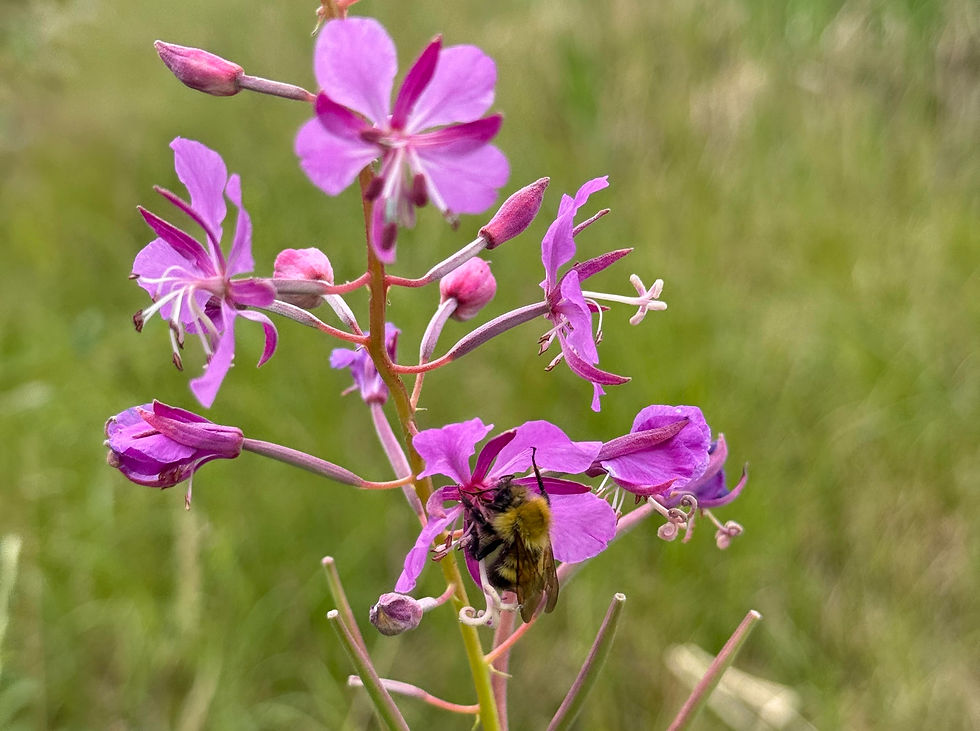Beneath the Surface
- Alisa Preston
- Jul 26, 2025
- 3 min read
Updated: Jul 27, 2025
Reflections On The Giant Mine and the Future of Remediation
~By Alisa, Monoceros Founder

Flying into Yellowknife, Northwest Territories, you’re greeted by a breathtaking panorama: a glacier-carved landscape stretching endlessly, dotted with lakes, rivers, and muskeg. In July, it’s a vivid tapestry of blues and greens and a splash of bright pink and yellow from summer wildflowers, though the region spends close to eight months of the year frozen. From above, it’s easy to believe in nature’s resilience. But hidden beneath this beauty is one of the most haunting legacies of Canada’s resource economy: the Giant Mine.
During my studies to become a Chief Sustainability Officer, I focused on large infrastructure systems and the undeniable reality that modern society depends on resource-based industries, including agriculture, fishing, forestry, and mining. These sectors form the scaffolding for much of what we take for granted in our day-to-day lives. However, the outdated "out of sight, out of mind" mindset, the belief that a vast ocean or a sparsely populated landbase could absorb our impacts indefinitely, no longer holds up. The environmental legacies of past industrial practices are catching up with us.
Innovation is driving much-needed progress toward cleaner technologies, but at Monoceros Strategies, our focus is different. We’re working to remediate the harm already done; to address the long-term impacts of extractive industries while also offsetting the footprint of today’s transitional practices. True sustainability requires not just change moving forward, but repair looking back.
Giant Mine is a stark case study of why legacy contamination demands more than containment; it requires real remediation.
Just a few kilometres outside Yellowknife lies what was once one of Canada’s richest gold mines. In the mid-1930s, prospectors discovered a lucrative gold vein adjacent to Great Slave Lake. Over the decades, Giant Mine produced more than 700 million ounces of gold. But that gold came at a cost: arsenic trioxide, a toxic byproduct of roasting arsenopyrite ore to extract the gold.
In the early years of operation, arsenic-laden gas was released directly into the atmosphere at dangerously high concentrations. Scrubbers were eventually introduced to reduce emissions, but they simply transferred the problem underground: the captured arsenic trioxide, over 237,000 tonnes of it, was stored in frozen chambers beneath the permafrost with the intention that it would stay frozen indefinitely.
But the climate is changing.
The site’s frozen-block containment strategy relies on thermosyphons to keep the arsenic-storing chambers below freezing. As global temperatures rise, the long-term reliability of this method comes into question. If the permafrost thaws, we face a terrifying possibility: seepage of arsenic into nearby groundwater and ecosystems.

What struck me most about my visit wasn’t just the history, or the scale of the operation; it was the present-day reality. Unlike the conspicuous industrial corridors around Vancouver or Edmonton, Giant Mine is almost swallowed by the northern landscape. Yet the danger remains very real. Bright red warning signs encircle the area: DANGER! | CONTAMINATED AREA | KEEP OUT

Meanwhile, life including plants, birds, and small mammals, continues just outside the berms; a jarring juxtaposition of resilience and risk.
Seeing the site in person brought the academic research I’ve done into sharp focus. It reaffirmed why our work at Monoceros Strategies matters. We can no longer accept remediation plans that simply store, relocate, or cover up contaminants. We need approaches that heal ecosystems, not ones that gamble on perpetual containment.
Natural solutions, like those we are developing through mycoremediation, offer promising paths forward. But they require investment, collaboration, and a willingness to confront uncomfortable truths about our past.
Giant Mine is a legacy site, but it’s also a call to action. Let it remind us that the real work of sustainability isn’t just building a better future; it’s repairing the damage we’ve already done.

Comments